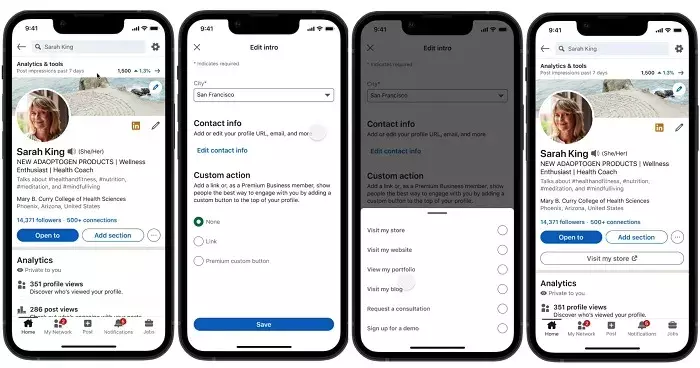LinkedIn, the social media giant primarily known for professional networking, has made a controversial decision: the removal of the custom link feature for user profiles. Previously a highlight of their Premium subscription service, this feature allowed users to add personalized call-to-action (CTA) buttons that linked to their external websites, portfolios, or stores. While this change has sparked discussions, it’s essential to dive deeper into the implications of LinkedIn’s decision and what it means for its user base.
The custom CTA buttons, first introduced in 2023, were designed to enhance profiles and drive external traffic. Users could select from options such as “Visit My Store” or “Schedule a Call,” which then redirect visitors to URLs of their choice. However, this functionality will now discontinue for new entries, meaning that while existing buttons will persist, users can no longer modify or add new links. This raises eyebrows—especially since LinkedIn claims to prioritize member value and user experience.
The Numbers Behind Premium Subscription Growth
LinkedIn boasts approximately 175 million Premium subscribers, a remarkable increase of 50% in just two years. This growth can be partly attributed to the introduction of enhanced features like the Premium Company Pages, which present a more visible platform for businesses to engage customers through custom CTAs. This contrasts with the recent decision to limit individual user options. It’s ironic that while businesses are granted more visibility and tools to capture attention, individuals are stripped of options that once set their profiles apart.
The lack of synergy between individual users and businesses raises questions about LinkedIn’s priorities. Are they shifting focus predominantly towards corporations at the expense of professionals looking to elevate their personal branding? There’s a clear distinction in resource allocation; individuals may feel increasingly neglected as LinkedIn caters more to corporate clients and brands. Furthermore, it triggers a discussion on whether LinkedIn genuinely serves the individual’s networking needs in a landscape increasingly demanding traditional business tools.
The Potential Impact on User Engagement
Critics argue that this change undermines the potential for personal connection and engagement that LinkedIn so heavily promotes. The platform thrives on facilitating professional relationships, and custom links served as a grooming tool for focused networking, enabling members to present their own offerings distinctively. By removing this feature, the platform risks becoming increasingly homogenous—profiles could blend into one another, lacking the unique flair that custom CTAs provided.
Moreover, the narrative that users aren’t leveraging this feature effectively seems misaligned with the platform’s goals. If LinkedIn is nudging users away from external links because they believe that traffic generated from profiles isn’t substantial, they should reconsider their approach. Instead of suppressing individual creativity, LinkedIn could invest in mechanisms that emphasize the value of these outbound connections—encouraging users to craft compelling profiles that showcase their expertise or services rather than stifling their potential.
Reasons Behind LinkedIn’s Decision
Despite the lack of a clear rationale from LinkedIn, speculation suggests concerns over SEO impacts and the quality of shared links may have played a part in this decision. The platform could indeed be trying to protect itself from potentially harmful external content, which by default positions LinkedIn’s integrity and credibility at stake. Yet, this reaction seems to patronize professional users who have historically leveraged LinkedIn to project their personal brand.
This entire situation raises an important question: Where does LinkedIn draw the line between protecting user experience and enabling individual expression? The very essence that differentiates LinkedIn from other professional platforms rests in the diversity of profiles—a myriad of experiences, services, and unique ventures. Taming the individuality that exists among users by withholding valuable features only serves to dilute the connectivity that makes LinkedIn special.
Future Implications and User Reactions
The reaction from users and industry experts is crucial in assessing the impact of this strategic move. Reactions range from frustration to indifference; many professionals are skeptical about the broader implications of LinkedIn’s retreat from facilitating direct traffic. As a platform that seeks to elevate professional voices, this decision could lead to disengagement, forcing users to reconsider their investment in time and effort on LinkedIn.
If LinkedIn genuinely aims to be a key player in nurturing professional growth, a balanced approach must take precedence, where both individual users and businesses feel empowered and valued. The conversation is far from over, and as trends in professional networking evolve, LinkedIn must keep its finger on the pulse of a changing user base that thrives on both personal and professional engagement.

